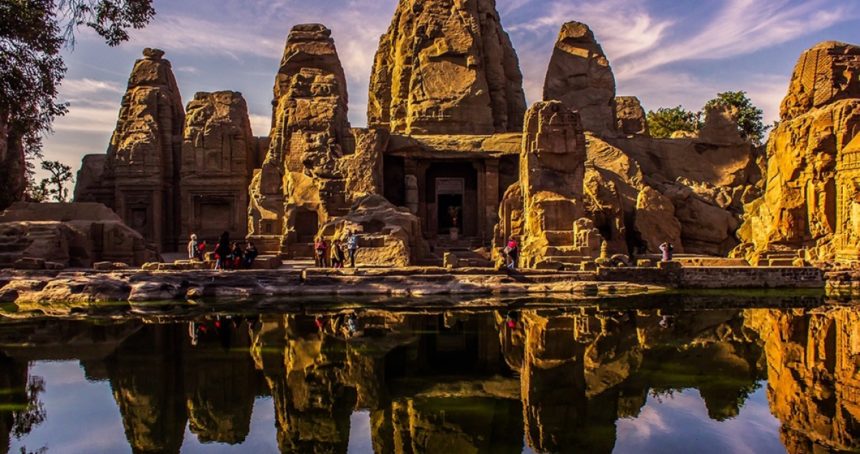The Dhauladhar range is home to one of the few monolithic temples carved in India.
Rock Temple of Himalaya – Masroor

Himachal Pradesh is called Dev-Bhoomi which means ‘Land of the Gods’. True to its name, the beautiful landscape of snow peaks and apple flowers is also dotted with several temples, monasteries and places of worship. But in a secluded corner of this pine-scented state, stands tall a surprise, not known to many and away from the tourist’s gaze.
In the vicinity of Maharana Pratap Sagar dam, which confines the blue-green waters of Beas nestled in Shivalik hills, is the tiny town of Masroor.
The Kangra valley enfolds in front of you as you travel through unending hillocks and humble forests of pine and other trees interspersed with small villages. The vista is not as majestic as seen in the higher Himalayas, with tall and strong devdar trees on the steep climbs and deep valleys laced with snow-capped ranges, but this region has its own charm! The brown dwarf hills and fresh green pine leaves all swathed in the warm afternoon sun, the litchi and mango orchards, the terraced fields of wheat and occasional mustard, the twisted turns and bends, the large expanse of the golden valley, all add to the magic called Himalaya!
Masroor, our destination is a little off the normal tourist circuit but without a doubt, is far more rewarding!

As you take a final turn, right in front of you stands the massive stone sculpture called Masroor Rock Temples in its full glory. This is a monument cluster of 15 temples, four large temples in the last row and smaller five temples in the front row and some more around it. Point to note, all are carved out of a single stone! A monolithic sculpture indeed, of a grand scale and magnificence!
India has very few fully rock-carved temples standing. The biggest and most celebrated being the Kailash temple at Verul in the Sahyadri range. Monolithic architecture requires strong stone boulders, which are in turn carved to perfection by artisans of a lost era and only then we get the magnificent monuments like Mahabalipuram or Kailash Temple.
Nothing less than a marvel, these Masroor temples in the lap of Himalaya are unique since the rock required to carve out such intricacies is not easily available in Himalayan ranges. Himalaya being the young mountains in their formative stage have a tendency for landslides. However, this particular stone has been rock steady for years and has allowed the sculptor’s hands to adorn it with a chisel. The Masroor Shiva Temple stands erect here under the shadow of the mighty Dhauladhar ranges and has its gaze beyond the fertile valley of Beas.

The imposing shikhars of larger temples are carved in ‘Nagar’ style with fine high reaching lines and intricate carvings. Although it is a temple cluster, the temples are all integrated from the inside. The main shrine has staircases to reach the middle level. The very impressive door frame with a large door opening of the main temple takes you to a peaceful and serene sanctum. The main sanctum currently has murtis of Ram, Sita and Laxman, probably brought in at a later period.

In reality, this is a Shaivite temple complex depicting ‘Kalyan Sundar’ manifestation of Shiva which implies Shiva-Parvati marriage. The massive pillars with very ornately carved pot bases, the interwoven designs on the high rising pinnacles and the beautiful floral designs combined with geometric designs on the walls, weave such magic for the viewers.

The sculptures on pinnacles include the ‘Trimutri’ face carved in the centre of the Shikhar. This is observed in several Himalayan temples. Experts think it is the depiction of the three faces of Shiva. The figures carved on the temple walls are those of Shiva, Parvati and Kartikeya.
The rectangular tank in the front of these temples is filled with serene water and this water presence gives a dreamy look to these magnificent and artful stone structures.
Since the architectural and sculptural style of these temples matches that of Elephanta (Gharapuri) caves near Mumbai, the temples might have been sculpted between the 8th to 10th century CE.
Not much information about the patrons of this wonderful temple is known. There are a few inscriptions in the temple but they are not been deciphered. However, this could be the creation of Lalitaditya, the contemporary king of Kashmir or Yashovarman, the king of central India. Recent research also tells us about similarities between this temple complex and the celebrated temples in Cambodia.

Sadly, part of the left side of the temple has fallen very badly and this could be due to the massive 1905 earthquake in this area. Also, the structure is unfinished and one wonders why it was abandoned. Even with its imperfections, the beauty and scale are as impressive as ever.
Leaving Masroor is difficult! Nestled in Himachal, away from the rest of the world, stands here such a unique piece of architecture which is totally off the radar for the usual tourist who does not even know what they are missing.
But then again, the sheer importance of this place in ancient Indian architecture can never be forgotten.

Leave a Reply